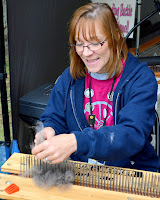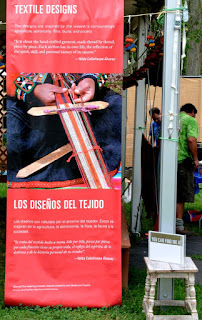Little Knitty Bird is partnering with Little Washington Winery to run a knitting day up in the mountains on November 8th! Join us for Yarn and Wine by the Fireside a lovely day in the shadow of the Shenandoahs with wine, yarn, guest speaker Joyce Hall from Posey Thisisit Llama Farm , and a gift bag with yarn, a pattern, and custom Little Knitty Bird stitch markers! Get tickets now so that we know how many to expect and can get enough supplies, I can't wait to meet everyone!
Now time for Fiber!
How could you not love these faces though?
There is never any lack of fiber animals at the festival which makes it a real treat for Littlest Owl. We made sure to let her visit all her new friends as soon as we got there. The alpacas in particular were rather friendly and eager to make her acquaintance.
New Friends! Owen the Rabbit is happy to pose.
These sweet visitors from Central Hill Alpacas were ready for their close-up.
One of the awesome things about this festival is that it's not just a large yarn show, but truly is a fiber showcase taking you all the way from hoof to yarn and exhibiting all the steps along the way. In about every other exhibition tent is someone actively spinning and supplies are bountiful ranging from the "pick-a-fleece" table, to both dyed and un-dyed roving, non-wool raw and un-dyed fibers, dyes, looms, spinning devices, and finally the yarn.
Pick a fleece, any fleece.
Raw and undyed fibers from the folks at Hipstrings who also make some beautiful drop spindles.
Roving as far as the eye can see!
This includes some more unusual forms of spinning and fiber work, such as the doctoral project from Spindlebars. Julie Obenauer-Motley and her fellow doctoral candidates were posed with a challege: use a bicycle to solve a problem in the developing world. What caught their attention was the problem many fiber producers have in actually milling their own fiber. Fleeces are produced, but then have to be sent to a third party manufacturer for processing. The resulting yarn is then sold back to the fiber farmers for prices they can scarcely afford. So Julie and her team mates contacted Terry Clark of Three Peaks Crafts to see if he could collaborate with them. Their answer was to convert a bicycle to use as a spinning wheel. Bikes are particularly common in developing nations and relatively easy to access. Converting one into a spinning wheel would give a small fiber farmer the ability to make their own yarn, avoiding having to send everything they would personally use to the third party producer, putting production back in their own hands. The students are in the research phase, testing out their design and getting feedback and I was able to learn about the process from Julie and Mrs. Clark. The team is looking into commercial viability of the project to see if they can create a one-for-one model to enable consumers to purchase a Spindlebar for themselves and accordingly gift one to a fiber producer elsewhere. Check out their site and let the team know what you think!
Of course the festival wouldn't be complete without tons of wonderful, beautiful yarn! Yarn makers from all over the Shenandoah mountain region were featured including some right near Berryville itself, where the festival is held.I'm still trying to knit through the stash that I bought last year so I managed to limit myself to only one skein this year. I had difficulty prying it away from Littlest Owl, however, once I let her check it out.
Fiber Appreciation starts early.
The festival is always full of various learning opportunities, whether officially through the scheduled set of classes and demos, or casually from the fiber workers at their own booths.
Here Valerie Kellam of Frolicking with Fiber shows how she can use her wool blending hackle to blend different colors of roving together before spinning.
In one of the exhibition buildings was the Blue Ridge Spinning and Weaving Guild and their teaching and demonstration area.
Littlest Owl gets to learn about using a loom.
Now time for more views of the festival and some of the wonderful vendors that were featured this year.
Blue Ridge Yarns at the Misty Mountain Farm booth.
Lovely yarn and super cool 3D Printed drop spindles from Turtle Made.
The always lovely Shalimar Yarns.
Neighborhood Fiber Co. I was really excited to see these folks. I got my degree up in Baltimore and I love the idea of an urban yarn company like this taking inspiration from Charm City itself! They just opened up their new retail shop on 700 N. Eutaw St., hopefully I can get up there soon to see it!
It's a yarn truck! I've been reading about these new businesses taking off and have been absolutely fascinated by the concept. Knitting Addiction is one of the few (if any others indeed!) of these on the East Coast, based out of North Carolina. I may have been a little too excited to see them!
Candy Hargett and Bill Kimsey from fiber.ing at Calluna Farm Studios were enough to make me homesick again for Colorado with their style of weaving and yarn making! Candy is working here on the quietest electric spinning wheel I've ever seen. She fell in love with the brand so much, they became an authorized dealer for them!
And speaking of unusual fiber work, check out this Civil War sock knitting machine from the folks over at Appalachian Sock Company. It was fascinating to get to watch this machine do it's thing!
It was a another wonderful event and I look forward to what they'll have going on next year!










































































